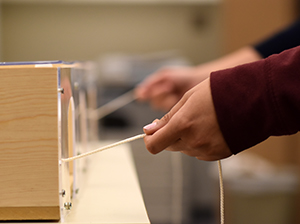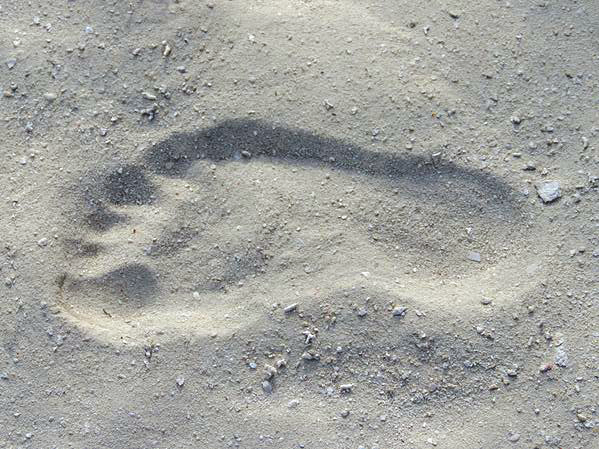
Pull it off
Before you begin
Our relatively big brains allow people to work together to accomplish tasks that benefit everyone.
Even very young human children can learn simple games such as working together to pull a board. They can also figure out a fair way to share the rewards from cooperating.
This activity may seem simple, but humans are the only animals with the ability and desire to work together and negotiate a fair deal in this way. With effort, other primates can learn to work together to pull the board toward themselves. But, they have a difficult time sharing the rewards, which puts future chances for cooperation at risk.
Why do you think it is important for people to cooperate? Could cooperation have helped humans in the past?
What you will need
- Rope and board apparatus (see instructor instructions)
- Supply of small rewards
- Videos of children and primates attempting the challenge (optional)
- Instruction packet [PDF]
Procedure
 Find a partner and stand in front of the apparatus. Each of you pulls one end of the cord. Work together to bring the board to the other end of the box.
Find a partner and stand in front of the apparatus. Each of you pulls one end of the cord. Work together to bring the board to the other end of the box.- Collect the prizes from the cups on the board.
- Now, run the experiment again, with prizes in different cups.
Learn more
It’s not just our brains that give us an advantage—it’s our social nature. Scientists think humans evolved to be social, and society and culture evolved from human nature.
Our big brains enabled us to live in complex social groups, a trend that has continued through many millions of years of primate evolution. While other animals live in social groups, only humans have developed such variety in our social structures and in our culture.
Our big brains enabled us to live in complex social groups, a trend that has continued through many millions of years of primate evolution. While other animals live in social groups, only humans have developed such variety in social structures and culture. Fossil evidence shows that our ancestors cared for the sick and elderly members of their groups. For example, there are several fossils of Neanderthals that show evidence of old injuries that healed, which means that those injured Neanderthals may have been helped by their group members.
Read more about human cooperation here: https://askananthropologist.asu.edu/stories/theres-no-i-human
Bibliographic Details
- Article: Pull it off
- Author(s): Amy Peterson
- Publisher: Arizona State University Institute of Human Origins Ask An Anthropologist
- Site name: ASU - Ask An Anthropologist
- Date published:
- Date modified:
- Date accessed: January 16, 2026
- Link: https://askananthropologist.asu.edu/experiments/pull-it
APA Style
Amy Peterson. (). Pull it off. Retrieved 2026, Jan 16, from {{ view_node }}
American Psychological Association, 6th ed., 2nd printing, 2009.
For more info, see the
APA citation guide.
Chicago Manual of Style
Amy Peterson. "Pull it off." ASU - Ask An Anthropologist. Published . Last modified . https://askananthropologist.asu.edu/experiments/pull-it.
Chicago Manual of Style, 17th ed., 2017.
For more info, see the
Chicago Manual citation guide.
MLA Style
Amy Peterson. Pull it off. ASU - Ask An Anthropologist. , {{ view_node }}. Accessed January 16, 2026.
Modern Language Association, 8th ed., 2016.
For more info, see the
MLA citation guide.
Experiment Packet
Be Part of
Ask An Anthropologist
By volunteering, or simply sending us feedback on the site. Scientists, teachers, writers, illustrators, and translators are all important to the program. If you are interested in helping with the website we have a volunteers page to get the process started.

